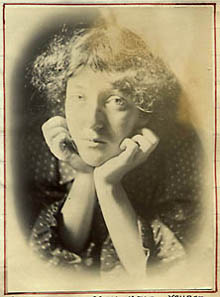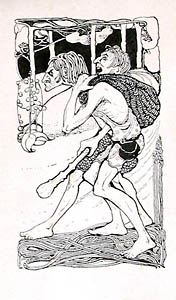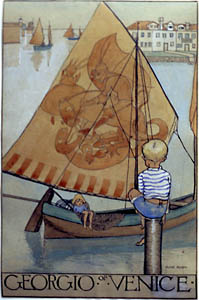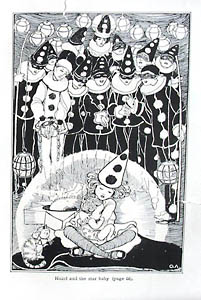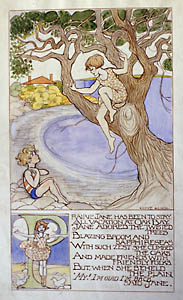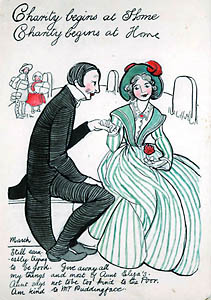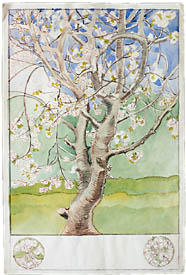Olive Allen Biller
In 1996 I met the son and daughter of Olive Allen Biller, a Golden Age children's book illustrator from the UK who had moved to Canada around the time of World War 1. Between them, they had several hundreds of items, from sketches to finished works to manuscripts to diaries. I began cataloguing it all, a task I had to leave incomplete. I did however facilitate some works going to The University of British Columbia.
The text below is from a presentation I made in Windsor, Ontario at the Feminist Research Group's annual conference, Interactions, in 2005. Some of the images appear to the right.
The Life and Work of Olive Allen Biller
INTRODUCTION
This poster represents early scholarly research on the artist Olive Allen Biller. Although she had a significant career in England as a book illustrator and later studied with Jock Macdonald and F.H. Varley, and showed her paintings in Victoria and Vancouver, BC, she has been completely overlooked in the art historical record. She might have remained forgotten had it not been for the chance meeting of Dr. Michael Willis, an art historian and also my uncle, and Mrs, Jill Sims, Biller's daughter. Dr. Willis recognized the work hanging in Mrs. Sims' home as having merit, and through him, I was encouraged to meet both Mrs. Sims and her brother John Biller. They have both kindly allowed me access to their collections. Only one of Biller's works is in a public collection (BC Provincial Archives) so without their generosity this work would be impossible. I owe my deepest thanks to the family for the opportunity they have provided me.Since 1996 I have been cataloguing and photographing the works in the collections and published works. So far there are over 500 entries, perhaps 65% of the total. Previously unaccounted-for published work in children's annuals is occasionally showing up, while other family members hold works I have yet to see.
Theoretical or critical inquiry into what Biller's life and work means has not yet begun [at time of writing, 2005]. However, there are several interesting aspects that suggest relevant themes. As a British immigrant Biller came to Canada with a worldview similar to that of the dominant order, but she came as a woman and as an artist, with a willingness to notice and record elements that escaped the eyes of her peers. For instance, she finds beauty in the "empty" prairie, value in the everyday activities of children, and honour in the Chinese labourer Wong. At the same time, she shares in the common Canadian Nationalist fervour of her day, celebrating the landscapes of the West Coast as did her contemporary, Emily Carr.
1.
BORN: October 17th, 1879 in Ormskirk, England (near Liverpool). From the age of 4 she lived in Launceston, Cornwall, where her mother ran a boarding school. Her father, George Lupton Allen, was a Methodist minister.2.
"Anna" is the nickname Olive went by at home. As a child they teasingly called her "Bad Anna." She protests in an undated poem:They were themselves not very good,
And Anna was MISUNDERSTOOD...
...But Anna never would consent
To thwart th'artistic temperament.The theme of playful naughtiness recurs throughout her work.
3.
For many years the Allens vacationed at Trebarfoot, a medieval farmstead on the Cornish coast near Bude. Author Harold Avery is among many guests who joined them. Miss Allen painted the scenery often. The locale inspires scenes in her book illustrations and at least one published story. The family kept scrapbooks of their activities there, complete with photos, drawings by Biller, and other creative works such as posters, stories, and poems.4.
Allen's considerable talent allowed her to work in several styles. Her work is in keeping with the popular styles of the day of Art Nouveau and the Arts and Crafts movement.5.
In 1904 Miss Allen went on a long and rather lively painting trip to Italy with two friends. In a letter Allen remarks, "I am getting tired of [Neenah's] love affairs - they seem to interfere with everything and we can't ever work."6.
Olive Allen illustrated at least ten books, and wrote and illustrated an unknown number of short stories for children's annuals and magazines, including Blackie's and Girl's Realm. The earliest book is dated 1901 (she was 22!) and the latest about 1915.7.
The artist and her family and friends enjoyed producing plays and farces for their own enjoyment and for the community in Launceston and the school. Allen herself wrote some of these and acted in them. Later, in Canada, she writes plays for the children on James Island."Aunt Grundy, an exceedingly clever and humourous play by Miss Olive Allen... was performed before an enthusiastic audience....special mention should be made of the remarkably clever acting of the talented authoress as Miss Fanny Frivol...[it] was a consummate piece of acting, and one which provoked long and sustained applause." - an unattributed Launceston newspaper clipping, circa 1905.
8.
Her work is rarely political and she does not straightforwardly state her opinion on controversial subjects, but occasionally she gently pokes fun. In a series of menus, probably for a family event, she acknowledges the contemporary debate over women's suffrage. In one, the beautiful woman clubs a policeman into signing her petition, while in another a suffragette abandons her family to attend a rally. She herself seems to have believed in a balance of equal rights and family values.9.
Olive Allen's work sometimes wryly comments on the mores of previous generations and roles of women. In Clementina's Copy Book, the heroine struggles between her Christian duty and her youthful, flirtatious nature. There are 12 panels each playing on a common proverb, following Clementina's relations with young men. In the fable Wooden Doll Emma, the heroine attempts to land a husband but compromises her reputation to hilarious effect, resulting in the tongue-in-cheek maxim:"If you are plain you must be good!"
10.
In 1912 Miss Allen travelled to Saskatchewan's Qu'Appelle Valley region to marry, at 33, her long-time sweetheart, Jack Biller. He had come a few years before to start a farm. It was quite a change of life for Olive, who did not even know how to cook. Her first letters from Canada reveal considerable culture shock, complaining that the men have dirt under their nails and they "use the same knife for everything." She writes her children later that she had been a "spoiled girl." Within months she is working hard on the farm and writing beautiful descriptions of Saskatchewan to her family in England:"Through the silver-grey tree trunks we could see the blazing Western sky, faintly pink overhead and deepening to a brilliant red on the horizon. I was lost in wonder - Never in the world could there be such sunsets as these! Then Jack turned me by my furry bonnet to look Eastward - and the sunset sky was forgotten. Here was all the exquisite pale colours of mother of pearl, softly dappling the snow and shining in the sky.
"The sleigh softly swishing through the snow trailed upward to the open prairie. The beauty of it all was inexpressible - and I have seen many beautiful sights in my life. At last my eyes came back to Jack and the oxen. The big beasts' pie-bald red and white and black and white looked like a decorative picture against the snow, and Jack was best of all with some of the sunset reflected in his eyes." Olive Biller, January 12 1913.
11.
The Billers were extremely close. Olive returned to England in 1915 while Jack went to fight in World War 1. When Jack was killed in 1916, she was devastated. She wrote, "It was the end, I think, of my youth." It is possible she never fully recovered.12.
In 1919 she returned to Canada with her two small children John and Jill, to stay with her brother George Allen, a chemist and photographer (whose work is in National Archives), on James Island near Victoria.13.
From 1920-1924 Biller is the weekly correspondent on daily events on James Island, published in the Sidney Review. She uses the column to publish six of her own rhymes, and she writes a full page article (p. 6) on the history of James Island on April 13th, 1922. She also describes the plays she wrote for the kids, and the frequent pleasure outings everyone made to other islands to picnic. In a remarkable piece she valourizes the departing labourer Wong:"Our 'Char'"
He's the man who does the chores,
Cleans the windows, oils the floors,
Sweeps the schoolroom, minds the kiddies,
Saves the bits to feed the biddies.
When in turn we all fall sick -
Haven't the strength to cut a stick,
Fevers rising, pulses dwindling -
Wong steals round to chop our kindling.
Folks may say he's just a "Chink" -
Heathen Chinea - I don't think!
Mostly angels wear white wings,
Nightgowns and such airy things -
Sometimes harps - but I am sure
If an angel ever wore overalls and old tweed hat,
Very battered - Wong is that!By Olive Allen Biller, upon the departure of Wong to China.
13.
In 1927 the Billers move to Oak Bay, in Victoria, so the children can attend high school. With opportunities for illustration few and far between Mrs. Biller's creative work gradually turns to landscape painting. She shows with the Vancouver Island Arts and Crafts Society, alongside Emily Carr.14.
In 1934 the Billers move to Vancouver so the children can attend university. Here, Olive takes classes at the upstart BC College of Art, operated by F.H. Varley of Group of Seven fame, and Jock Macdonald, and Tonchek Ustinov. She begins to paint more landscapes with expressive gusto, and shows in the annual exhibitions hosted by the Vancouver Art Gallery between 1933 and 1948.15.
In 1937 Olive goes on a trip to Tatoosh Mountainin the USA. She returns with an impressive watercolour that she then develops into two oil paintings, some of her best work.16.
Mrs. Biller never stops taking interest in children. She accompanied her friend, a teacher of a kindergarten for Japanese-Canadian children, and sketched the pupils, about 1939.17.
Olive Allen Biller passes away in October of 1957, in Vancouver, BC.CONCLUSION
In my opinion, Olive Allen Biller was prevented from realizing her full potential as an artist. One sees an abrupt decline after her arrival in Canada, with many unfinished works and fewer commercial contracts. Some reasons for this may be her sorrow at losing her husband in World War 1, the busy life of a single mother, the difficulty of doing business long distance, isolation from other progressive artists, and the general constraints upon women to take their professional work seriously. Another drawback is that illustration has been and often still is dismissed as "not real art," meaning there would have been little support for her in her forte in art circles. Perhaps, even more than for gender issues, this is why she has been so long neglected.
Art historical and cultural research is greatly enriched with the inclusion of remarkable women like Biller, in that women's contributions are hereby recognized, and art forms often overlooked are reintroduced as worthy topics of study.
SOURCES
Biller, John. Personal correspondence to MD Willis and J. Grove. Private collection.
Biller, Olive. "Our 'Char.'" Sidney Review, July 13, 1922, p. 5.
Biller, Olive Allen. Personal correspondence, 1912-1919 (unpublished), private collection.
Bridge, Kathryn. List of Vancouver Arts and Crafts Society Shows from records in BC Provincial Archives (unpublished).
Sims, Jill, ed. Italian Spring 1904: Letters Written and Illustrated by Olive Allen. Phantom Press, 2006.
Vancouver Art Gallery. Records of Annual Exhibitions, 1931-1957.
Willis, Michael D. "Olive Allen Biller." Dictionary of Art. London: MacMillan, 1996.
